
Table of Contents:
– Background
– Look and Feel
– Reticle
– Comparative Optical Evaluation
– Mechanical Testing
– Summary and Conclusion
– Your Pro and Con Breakdown:
– Testing Methodology
Background:
I first saw the S6 5-30×56 FFP Scope at SHOTShow 2023. I spoke to the Sightron representative there for a while about the new S6 line and what their thinking was behind it and what the goals were with it. The S6 5-30×56 FFP is essentially a follow up to the unfortunately named, but quite successful, SVIII FFP 5-40×56. That scope has found a lot of success for Sightron. The SVIII is an odd duck, though, with no direct analogue in most competitors’ lines. It has a huge 40mm tube, giving it a massive 40 mils in elevation, which it pairs with an equally huge 8x erector ratio. The thought with the S6 was to take the SVIII level of glass and put it in a scope whose features are right in the middle of the market.
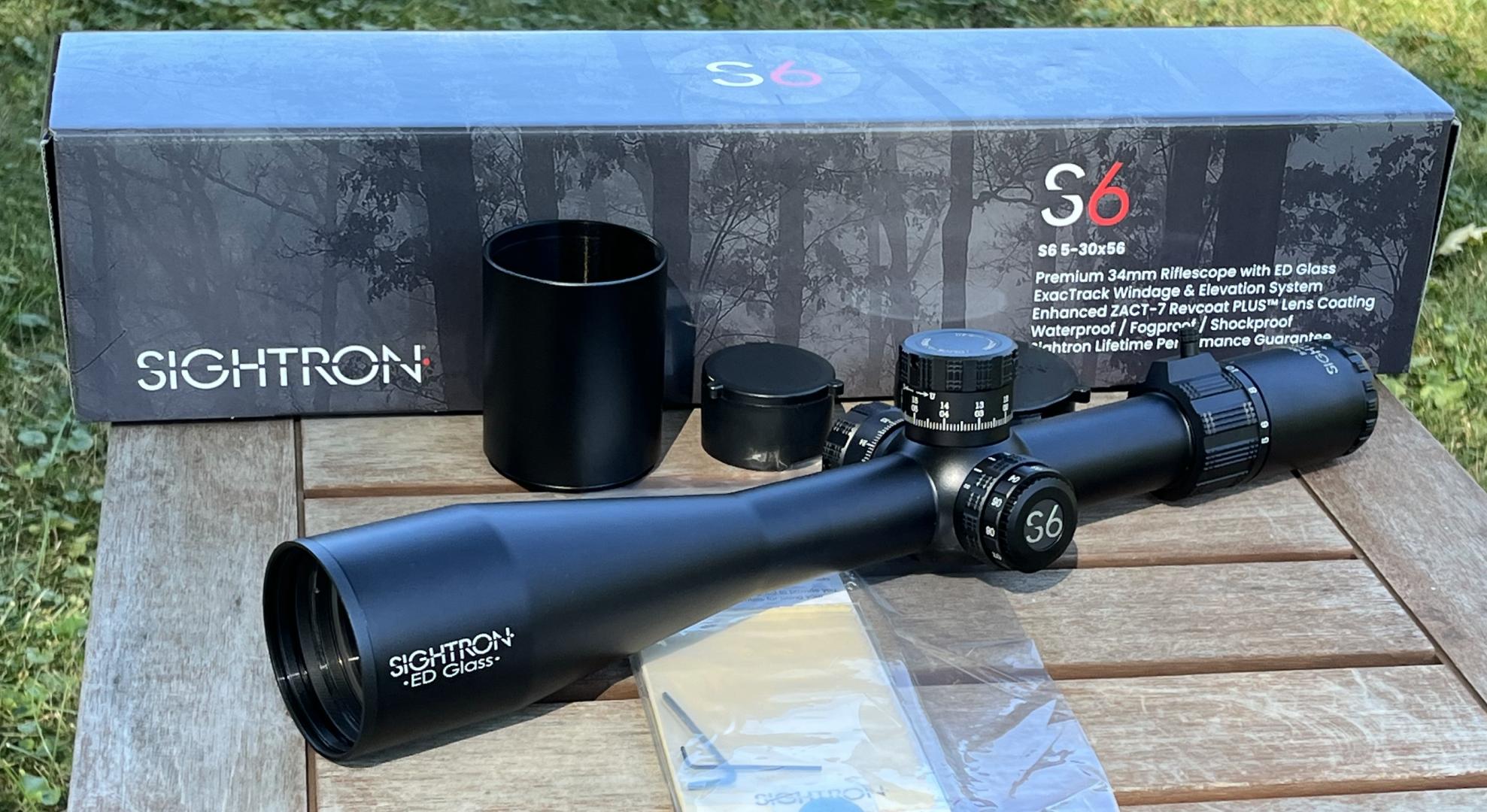
This will be a step up in glass when compared to the SIII PLR 6-24×50 FFP I reviewed last year. The S6 also represents a totally new optical design maximized for PRS type rifle use. This means that it will have greater depth of field, field of view, and erector ratio than the SIII, whose original optical design was maximized for target use at fixed and known distances.
Look and Feel:
Gone from the S6 is the bold, distinct, red and white styling of the SIII PLR that reminded me of 1990s Japanese electronics. Unsurprisingly given the SVIII’s success, they went with the same styling on the S6: plain white lettering and a little less flare on the knurling. All in all, pretty non-descript in general except for a big “ Sightron ED Glass” on the objective bell. Personally, I liked the distinctive red styling, but I don’t dislike the look of the S6. Probably, it doesn’t matter a whole lot. Vortex manages to sell an odd grayish scope better than about anything else and it doesn’t match anything. Schmidt also manages to sell scopes with alien gill-looking knurling on the power ring so looks can’t matter that much.
Extras included with the S6 5-30×56 FFP are a sunshade, flip caps, throw lever extending stud, battery, lens cloth, 2x hex wrenches, short manual, and reticle diagram. The flip cap on the objective lens of the loaner doesn’t stay closed, but otherwise it’s a nice set of extras.
Unlike the previous two SIII scopes and the S-TAC I reviewed, the S6 is neither light nor small. At 56mm, 33.3oz, and 16.56” long it is physically larger than average for the full size long range scope market with about average weight. As with the SIII, the S6 5-30×56 FFP is close focus capable, this time to just 10yds, making it a good rimfire choice. It is also a Japan made product.
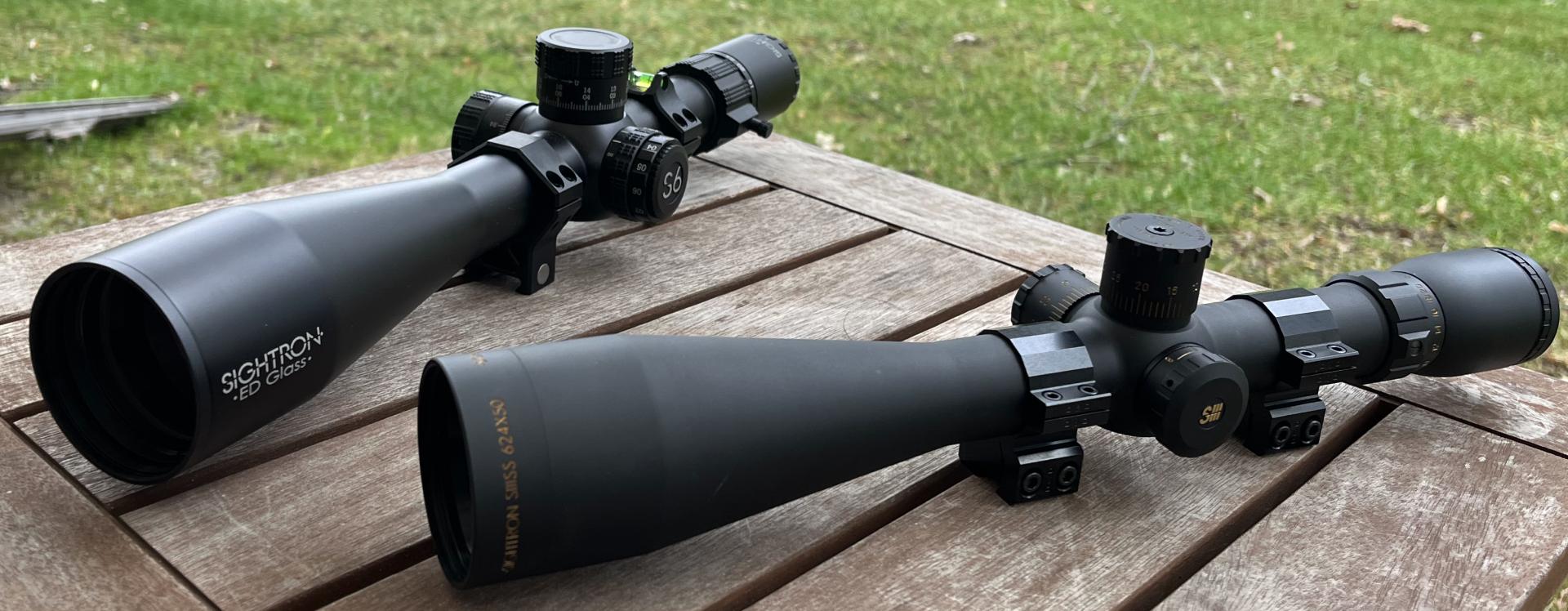
Also changed from the PLR in the S6 is the turret cap design. The single torx screw through the top used on previous Sightron scopes has been replaced with the three setscrew design most common in the industry. Notably, these are not the same size as the single setscrew that holds the zero-stop collar in place so you will need to keep two separate hex wrenches around to fully change the zero settings, and some engineer somewhere will lose his pocket protector for the transgression. The little one on the zero-stop is also very small, so be careful not to strip it. Also different in the S6 elevation knob is that the outer o-ring, and even the channel for it, are missing. Most scopes have an o-ring here. It’s not necessary for keeping the inert, moisture-free, environment inside the scope, but does help to keep dust and water from making a mess under the cap in the event of exposure to those environments. Importantly, it also largely determines the amount of force it takes to move the turret between the click detents. Removing it has the effect of making the turret feel less mushy and more clicky, but also makes it easy to skip over more than one click when rotating and lose click count. This happened to me a few times when testing adjustments. The S6 is by no means the worst case of this I have seen: it’s more of an edge case and I seem to really only lose count occasionally when going down, never up. You can be careful and keep count, but you can also be less careful and relatively easily lose count. Probably the reason this strikes me so much is not that the turrets on the S6 are bad, but that the PLR had some of the best feeling turrets of any scope I have ever tested. It would seem easy enough to just use that same detent and o-ring system to duplicate the great feel, but for whatever reason Sightron has departed from that. The takeway you should probably have from this overly long paragraph is that the S6 turrets are ok. I just think the SIII PLR has spectacular ones.
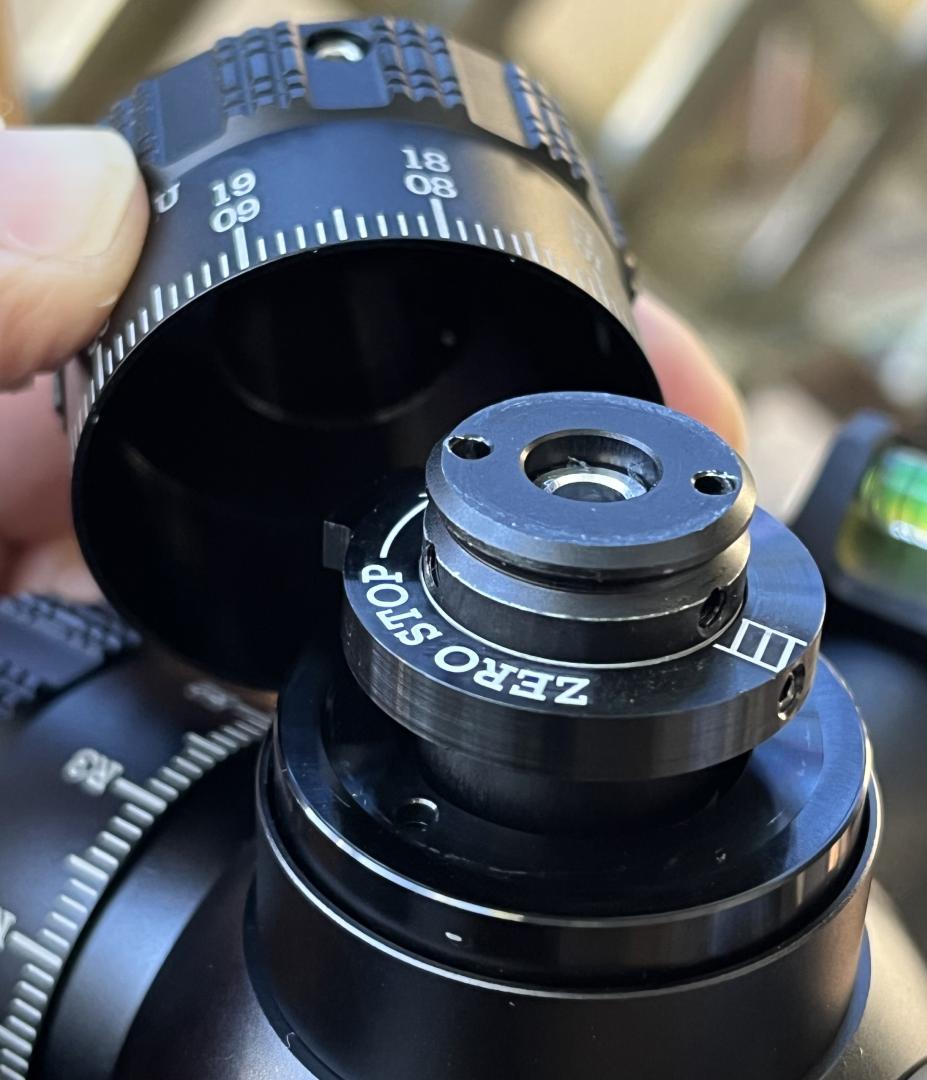
As for the other adjustments, The power ring moves with a nicely calibrated force, as does the parallax. The euro style diopter is super stiff, which is good since it is seldom adjusted and won’t accidentally move this way. The illumination switch is also on the stiffer side so it should not adjust on accident when moving the parallax. This is good as it does not appear the S6 has an illumination timeout feature so you could kill the battery by accidentally switching it on a setting too low to notice in daylight and unknowingly leaving it running.
Reticle:
At the time of this writing, the FFP version of the S6 5-30×56 ED is only available with a mil reticle whereas the 2FP version is only available in MOA. I do see indications that an FFP version is coming to the MOA crowd in the future though. The sample I am using is the mil version and its reticle is known as the MH-7.
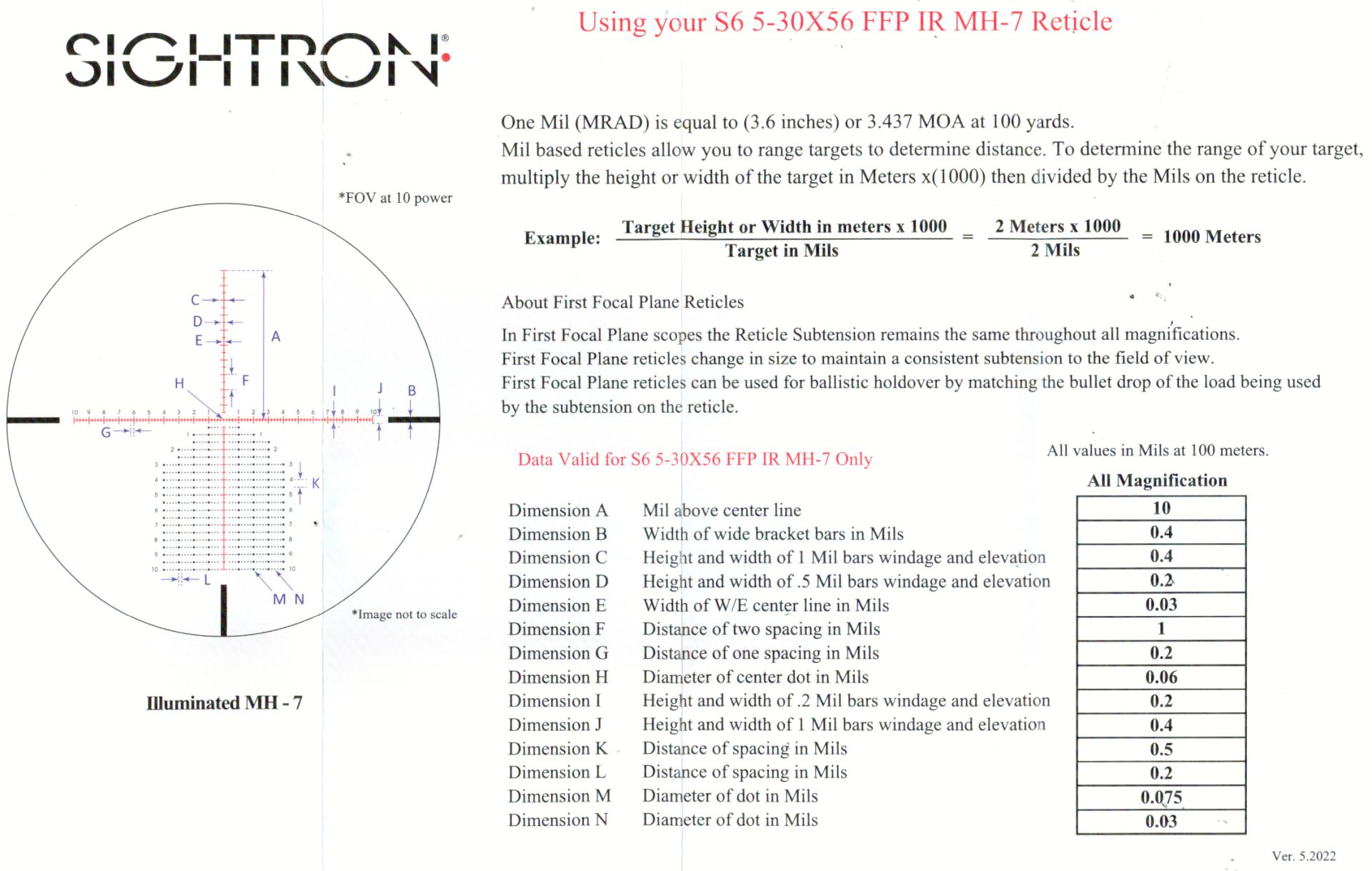
The MH-7 reticle in the S6 is quite similar to the Mil Hash-H available in the SIII PLR. So similar, in fact, that I reused a few sentences in this section. I’m not sure if that qualifies me to become the President of Harvard or if I would have to actually re-use others’ writing for that.
The principle changes in the MH-7 from the Mil Hash-H are the removal of the thick 12 o’clock post, graduation labels each mil instead of every other, and thinner line widths calibrated to look similar in thickness given the higher max magnification of the S6. There is also a larger graduated section on the MH-7, presumably to fit with its larger field of view. As with the Mil Hash–H though, the MH-7 is a basic one-size-fits-all mil tree reticle. It has the floating dot center and .2mil graduations on the horizontal you’re used to. For some reason, the vertical axis switches from .2mil graduations to half mil marks. The Christmas tree in the MH-7 is rather busy with .2mil graduated branches every half mil going down. I would classify the line thickness on the reticle as medium. It neither has caterpillar lines nor spider webs.
As with its predecessor, the MH-7 is a serviceable reticle. I wouldn’t call it a finely polished gem, but it’s not an ill-conceived train wreck either. It’s sort of a mediocre one-size-fits-all solution.
In testing, the reticle dimensions showed less than 1% deviation and there was no detectable cant.
Comparative Optical Evaluation:
At the time I began testing the S6 5-30×56 ED, I believe it had a MSRP of $1,599. Since then, I have seen it as low as $1,500 at a major online retailer and the current MSRP is $1,889. As such, I chose to test it with mostly ~$2k scopes, one of the higer cost and higher performing ~$1k scopes, and its predecessor, the SIII 6-24x50mm FFP in order to cover the range of prices I have seen. As per usual, I tested the scopes in a wide variety of lighting settings including bright sunlight, overcast, and dusk / dark conditions.
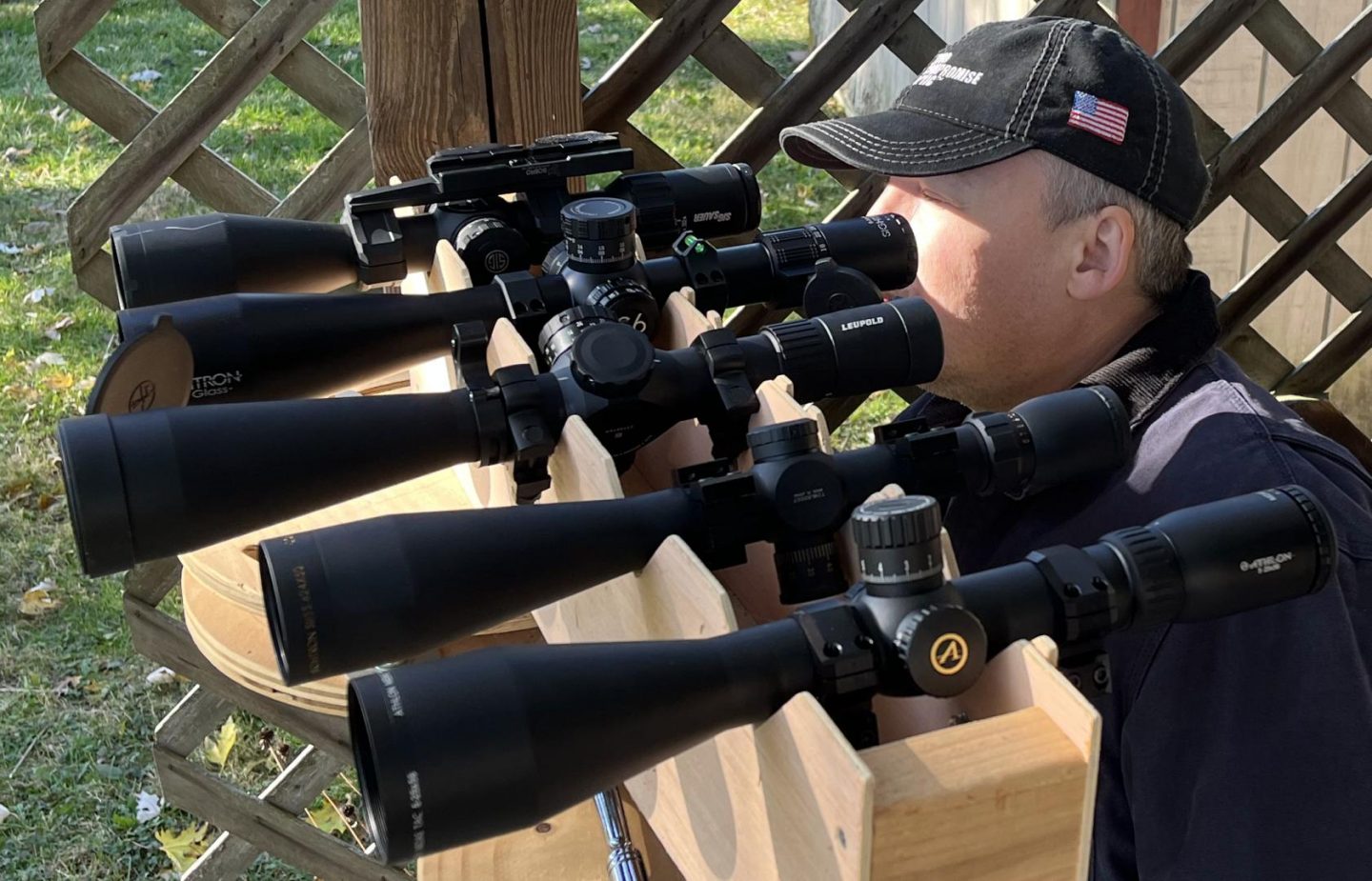
When I spoke to the rep last January at SHOTShow 2023 about the S6, considerable emphasis was put on its changes from the SIII PLR platform. That platform had begun its life as a second focal plane riflescope optimized for F-class competition. As such, it had excellent resolution but very limited field of view and depth of field. This S6 scope is an entirely new optical design that both seeks to better balance those two areas of performance, as well as to be just generally better as it uses higher grade ED glass.

As you can see from the FOV compilation image, the S6 certainly delivers on the larger field of view, not only relative to the SIII design but also to many of its competitors. It has the second largest FOV in the lineup, only being narrowly surpassed by the Minox LR. That is a big improvement over the SIII, which was easily the smallest. This performance in FOV does not come at the cost of stray light issues as it often can in designs. The S6 maintains Sightron’s typical excellent performance when it comes to stray light. Its stray light handling, combined with chromatic aberration performance that was the best of any of the scopes in its test lineup, generally saw the S6 perform better, relatively speaking, the worse the lighting conditions were. In addition to an emphasis on FoV, the S6’s design was also to have an emphasis on depth of field. Here Sightron again delivered. The SIII had very limited DoF and the S6’s is quite large. It again went from last by a large margin to second best.
Those were the high points of the design. Its low point is unquestionably resolution. I expected an improvement here over the much lower cost and lower magnification SIII design, but at high power I feel the SIII is actually narrowly better and the ~$2k designs are clearly better. The S6 was substantially better than the ~$1k Athlon, a very good ~$1k performer, and it was closer in performance to the ~$2k scopes than it was to the $1k ones, but not competitive with them on resolution. Its relative performance improves some if you look with the turrets 10 mil off center. In that case, it is clearly better than the lower cost SIII stablemate and closer to that of the ~$2k scopes. The S6 also fares a little better if you judge resolution at lower magnification (10x). Here it is a little sharper than the Sig but not able to catch its SIII stablemate or the Leupold.
Other aspects of the S6 5-30×56 ED’s were less dramatic either way. I found S6’s performance on contrast to be average for the group. I did not notice significant skewing towards preferring one or another area of the spectrum when it came to color. The S6 seemed to render pretty neutral. Eyebox on the S6 was a little on the tighter side for the group, but I didn’t find it problematic – and if I don’t find it problematic on the comparator stand, you’re not going to have an issue with the much better stability you get when you’re actually behind a scope on the rifle. I also saw a slight amount of pincushion distortion in the S6, but this is really only relevant on LPVOs and the S6 isn’t one of those, so who cares.
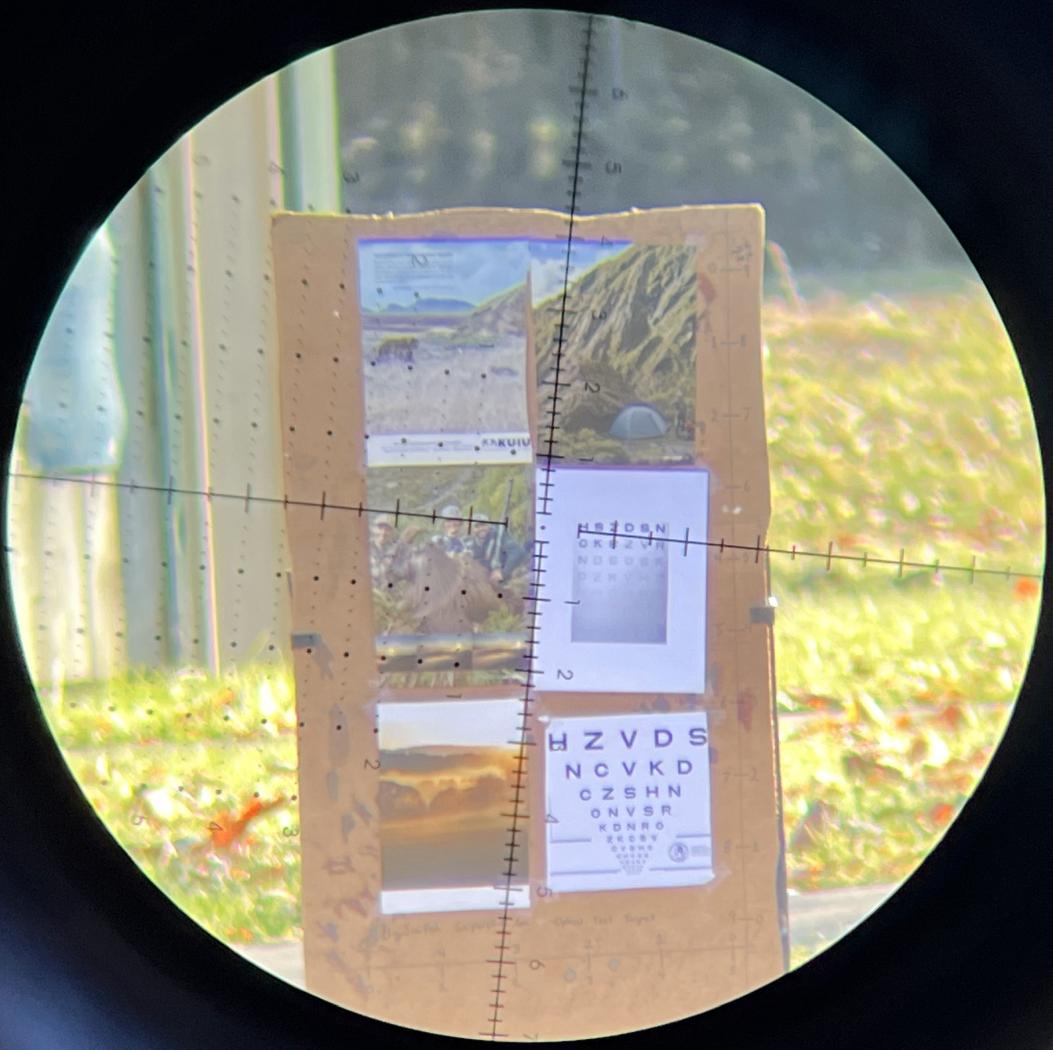
The longer I tested the S6 5-30×56, the better it looked, relatively speaking. This is because it did quite well on a lot of aspects of performance that you might not notice right away but that I test for, such as stray light handling from direct sunlight hitting the objective, performance with the adjustments off center by 10 mils, or depth of field. These things matter. The S6 is a very comfortable scope to be behind regardless of the lighting condition and for long periods of time. It’s hard to get over that initial impression of it just not being as sharp as its competitors though: resolution does matter. The S6 lags here, and it lags by enough that my overall opinion is that it is optically below average for the price class.
Mechanical Testing:
Most scopes have some deviation from perfect adjustment magnitude, though they are doing far better now than just a few years ago. This adjustment magnitude error will vary from example to example within the same model of scope. This is because it is not a product of design errors, but rather variances introduced within manufacturing and, particularly, assembly. So, the performance of my test samples is a piece of information with only limited value due to representing only one example. Often, we measure adjustment magnitude error as a percentage such that a scope whose reticle moves 10.1 mils when adjusted 10.0 mils tracks at 101% and one whose reticle moves 9.9 mils when 10.0 is dialed tracks at 99%. Frank has helpfully compiled a list of adjustment deviation of all scopes he has tested in class that can give you an idea of how often, and by how much, adjustment magnitude deviates from ideal.
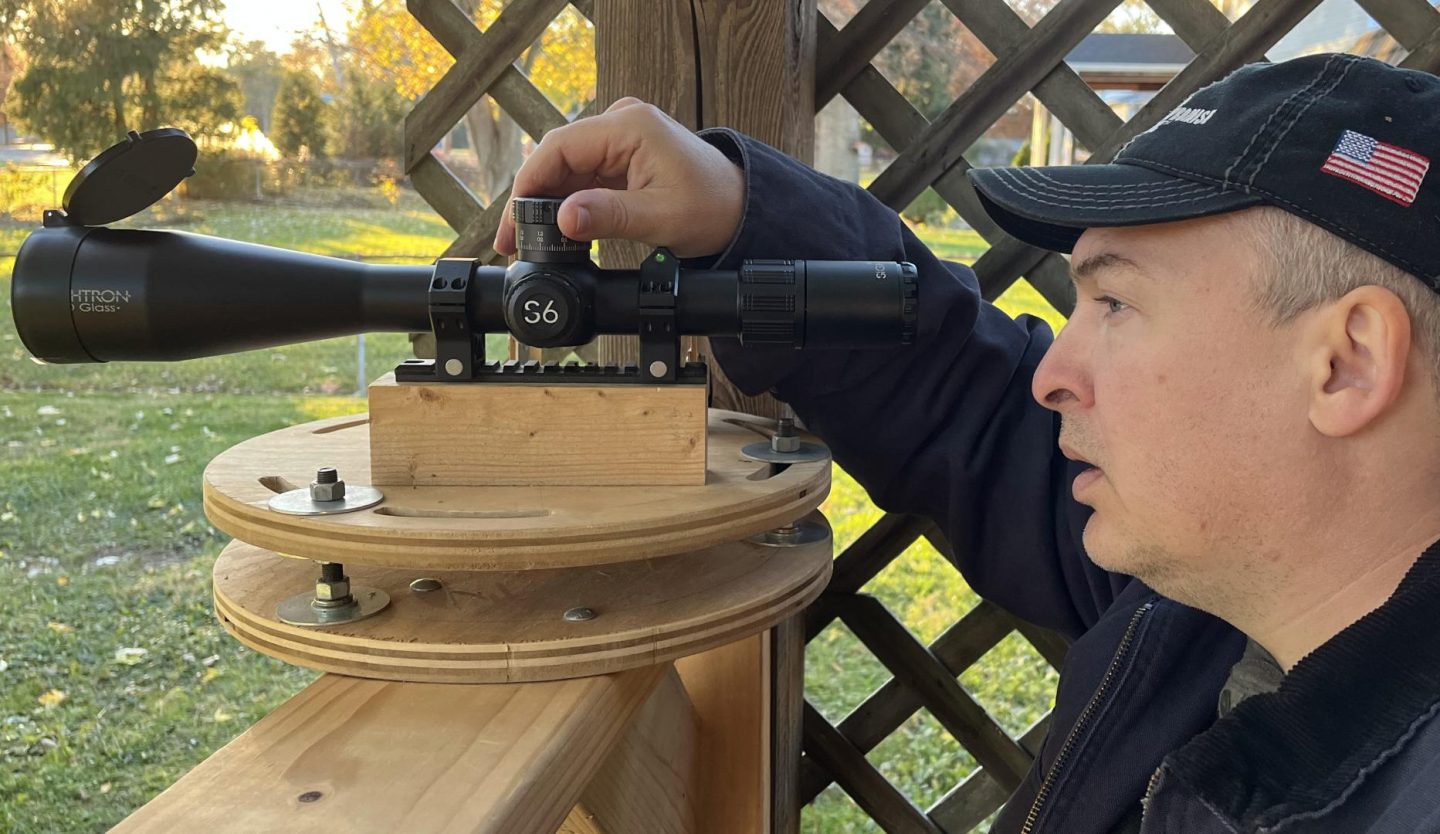
From center, the S6 tracked up 10.0 mils on the adjustments but 10.2 mils on target for a 2% adjustment deviation. Full up was 12.6 mils from center ,and turret and reticle movement stopped together meaning you don’t get any ghost turret movement. At 10 mils, the S6 could track 9.4 mils left to stop and 10.1 mils right with no tubing out either way. There is no windage stop restriction at 5 mils, so you get the full windage range of the scope. Despite this large windage movement, you get no tubing out. This is both great and unusual. Going down from optical center, 10.0 mils on the turret was again 10.2 mils on target. Full down was 13.3 mils and stop was again simultaneous for turret and reticle movement. This adds up to 25.9 total mils of elevation in my test sample which is a little more than the 23.3 mils claimed in the specs.
While a 2% adjustment magnitude deviation is not my favorite, I expect it is within spec for most manufacturers and is easily compensated for either in software or, more commonly, without even knowing it by DOPEing your rifle in the field and thereby having that deviation baked into the DOPE. The other mechanical controls for the S6 were all on point. There was no PoI shift with parallax, power, or diopter. The reticle was also calibrated to better than 1% in its size and showed no measurable cant.
Summary and Conclusion:
At 33.3oz, 56mm, 16.56”, 5-30x, and $1,889, the S6 5-30×56 ED FFP faces far more direct competition than the existing Sightron models, the SIII PLR 6-24x50mm FFP and SVIII FFP 5-40x56mm, most closely related to it. These models differ significantly in meaningful ways from most companies mainstream lineup. In the case of the SVIII, it has a mammoth elevation and power range. For the SIII PLR, its small size, low weight, and (sometimes) low cost set it apart from other Japan made scopes. The upside of this is that by having similar features, dimensions, and price, the S6 5-30×56 ED FFP will show up on more people’s radar when they are looking for a high power scope. The downside is that it faces a lot more direct competition.
I spent a lot of time during this review thinking about where Sightron fits in that competitive scheme. I didn’t feel like good performances in FoV, DoF, chromatic aberration, and stray light handling were enough to make up for resolution that was lacking and bring the S6 to a better than average performance in the $2k price bracket optically. Instead, I would characterize the S6 as below average for the ~$2k price class optically. Similarly, I found the feel and features of its turrets are below average for the ~$2k class as well. I think its biggest feature win is probably its 10M close focus parallax. That is a huge win for rimfire use and not something common in ~$2k scopes. None of the ~$2k scopes I compared it to here focus even near that close. The S6 also has a pretty complete feature set, having both illumination and a higher than average erector ratio and max magnification. These are not something all of the scopes have.
Cost-wise, at the time of this writing, The Sightron S6 5-30×56 ED FFP is sitting at $1,889 MSRP and $1,499 on the lowest online retailer I see. I think that $1,499 is a great value. The S6 is much closer to any of the $~2k scopes than to the ~$1k ones in optical performance. The $1,889 is more of a stretch. At that price, the potential buyer pretty much either needs the 10M close focus or has a better option elsewhere.
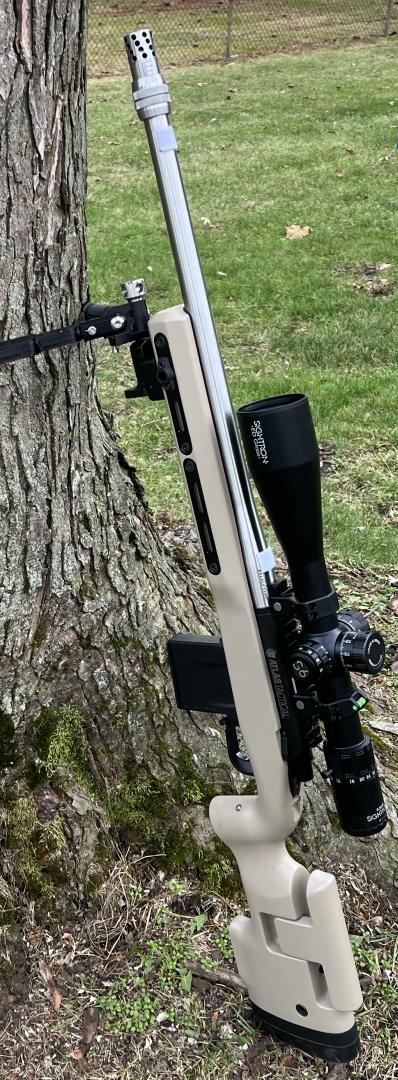
Your Pro and Con Breakdown:
Pros:
– Overall optical improvement over the SIII PLR 6-24×50 FFP
– New optical system has good FoV, DoF, and chromatic aberration
– Overall optical performance far better than scopes in the ~$1k price range
– Close 10M focus capability for rimfire
– Good extras with flip caps, throw lever, and a sunshade, though the objective cap didn’t stay closed
– Illuminated reticle
– Lifetime warranty and made in Japan
Cons:
– Resolution brought overall optical performance to below average for ~$2k scopes
– Turrets are basic in features and feel
– 25.9 mils of elevation is good for centerfire, but if I’m using that 10M close focus for rimfire, it is on the lower end of what I would like


